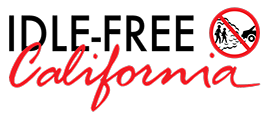Heavy-Duty & Fleets
California has more than 500,000 medium- and heavy-duty diesel trucks and buses - mostly commercial. Diesel engines are durable and economical sources of power. But, unless they contain the newer EPA mandated tighter emissions controls, they are significantly more toxic than gasoline engines, emitting many pollutants including particulate matter (commonly known as soot), nitrogen oxides (NOX), and sulfur dioxide (SO2). See What's in Diesel Exhaust? below and visit the Idling Facts page to learn more about the health impact of diesel exhaust.
Medium- and heavy-duty vehicles, most equipped with diesel engines, rarely need to idle for extended periods. Reducing idling yields benefits in avoiding fuel use and engine wear that increase the profits of individual drivers and company fleets (or taxpayer dollars saved for municipal fleets), improve health, conserve energy, mitigate climate change, and comply with California state idling restriction laws and client rules.
The cost of extended idling
While there are some legitimate reasons trucks and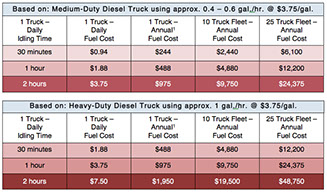 buses need to idle, in many cases excessive idling can be avoided. Even with recent lower fuel costs, it makes sense to shut engines off. Idling gets negative miles to the gallon. Profits are at stake for individual drivers and company fleets, and taxpayer dollars for municipal fleets. A heavy-duty vehicle burns about one gallon an hour. Two hours a day, with diesel at $3.75/gal. can cost more than $1,950 annually (260 day year); a 25 truck heavy-duty fleet brings that to $48,750. Plus, add half again for all vehicles idling excessively due to increased engine maintenance and shortened engine life.
buses need to idle, in many cases excessive idling can be avoided. Even with recent lower fuel costs, it makes sense to shut engines off. Idling gets negative miles to the gallon. Profits are at stake for individual drivers and company fleets, and taxpayer dollars for municipal fleets. A heavy-duty vehicle burns about one gallon an hour. Two hours a day, with diesel at $3.75/gal. can cost more than $1,950 annually (260 day year); a 25 truck heavy-duty fleet brings that to $48,750. Plus, add half again for all vehicles idling excessively due to increased engine maintenance and shortened engine life.
Engine makers: avoid extended idling
• Caterpillar Inc. "How much is idle time costing you" document states, "Turn off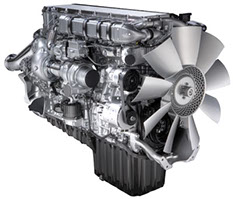 trucks that are waiting more than 5 minutes to load or unload." and "Restrict morning warm-ups to 3 to 5 minutes."
trucks that are waiting more than 5 minutes to load or unload." and "Restrict morning warm-ups to 3 to 5 minutes."
• Caterpillar Global On-Highway representative states, "There is no additional wear when shutting the truck on/off several times a day. There are benefits in fuel economy and wear/durability when shutting the truck down rather than idling."
• Cummins Inc. MPG Guide states, "...avoid unnecessary engine idling. The vehicle gets its worst mpg when the engine runs and the truck doesn’t move. Every hour of idle time in a long-haul operation can decrease fuel efficiency by 1%."
• Volvo US 2012 operators manual: "The belief that idling a diesel engine causes no engine damage is wrong. Idling produces sulfuric acid, that is absorbed by the lubricating oil, and eats into bearings, rings, valve stems, and engine surfaces."
• Detroit Diesel notes that along with other fuel-efficient habits, it’s critical to educate drivers on the role of shorter idle times. “Optimizing driver habits alone can improve fuel economy by up to 30%”.
• IC Corporation's engine manual states that "...Excessive idling reduces fuel economy, and may decrease oil life."
• Kenworth Truck Co. representative states, "Starting and stopping the engine is actually easier on the engine than prolonged idling."
• Navistar/International Trucks: "When a truck is stopped and idling, it is achieving zero miles per gallon. In fact, it burns through about a gallon per hour, decreasing overall fuel economy by 1 percent." "Unnecessary idling increases cost of ownership and also results in excessive engine wear and additional pollution."
What about truck regens?
To meet EPA emissions standards, newer trucks come equipped with emissions controls making them up to 90% cleaner than older diesels. This includes a diesel particulate filter (DPF) which must be regenerated to keep doing its job.
UNDERSTANDING REGENS AND MAKING THEM WORK EFFECTIVELY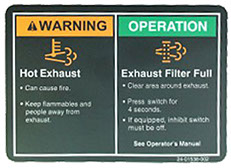
Under normal duty cycles, DPF regeneration occurs passively or automatically while the vehicle is driven, and the driver doesn’t do anything differently.
If a vehicle is not being operated under a normal duty cycle — lots of short stops and starts, excessive idling, etc. — a warning light will come on indicating that the DPF needs to be regenerated. The driver has two options – A) do a manual or forced parked regeneration, or B) drive the vehicle normally (40 MPH or more for about 20 minutes) and the regen will occur automatically. A common misunderstanding is that some drivers and fleet managers are not aware of option B.
To minimize fuel wasting parked regens, operate the vehicle as it was designed: normal duty cycles whenever possible, and minimizing idling. The more idling, the more parked regens required.
VIDEO BY CUMMINS fully explaining regenerations
BEST PERFORMANCE, GAS MILEAGE, AND LESS PARKED REGENS: ULSD ADDITIVES
Modern ultra-low-sulfur diesel (ULSD), while certainly cleaner than traditional diesel, is less thermally stable, which causes it to more readily break down into soot when introduced into today’s high-pressure fuel injection equipment. By treating ULSD with a thermal stabilizer, however, the fuel becomes less susceptible to thermal decomposition, reducing soot. To further minimize particulate matter in the exhaust, maintain a clean fuel system by using a diesel detergent, anti-foulant chemistry, and a corrosion inhibitor to prevent filter-plugging carbon deposits from forming and to keep injectors and other engine components in peak operating condition.
What's in diesel exhaust?
• Particulate Matter – [PM]: Linked to cancer, respiratory disease, cardiovascular disease and increased respiratory illness in children and the elderly.
• Nitrogen Oxides – [NOX]: Linked to problems such as shortness of breath, asthma, respiratory disease and decreased lung function.
• Carbon Monoxide – [CO]: Reduces the flow of oxygen in the bloodstream and is of particular concern to those with cardiovascular disease.
• Sulfur Dioxide – [SO2]: Irritates the nose, throat, and airways to cause coughing, wheezing, shortness of breath, or a tight feeling around the chest.
While diesel exhaust is particularly harmful for children and the elderly, it also has a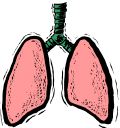 major impact on trucking industry workers. The Centers for Disease Control (CDC) study of occupational exposure to diesel exhaust has been conducted in truck drivers, bus drivers, dock workers and railroad workers. This study shows trucking related industry workers have higher levels of the health problems listed above.
major impact on trucking industry workers. The Centers for Disease Control (CDC) study of occupational exposure to diesel exhaust has been conducted in truck drivers, bus drivers, dock workers and railroad workers. This study shows trucking related industry workers have higher levels of the health problems listed above.
The monetary costs of diesel exhaust? Research by Proceedings of the National Academy of Scientists of the USA (PNAS) shows that fine particulate matter (PM2.5) air pollution was responsible for 107,000 premature deaths in 2011 in the U.S., at a cost to society of $886 billion. Twenty-eight percent of this -- $248 billion -- was associated with transportation!
EPA's Timeline of Major Accomplishments in Transportation, Air Pollution, and Climate Change has resulted in significantly lower toxic emissions over decades, but most of the current fleet of heavy-duty diesel vehicle emissions remains uncontrolled. These older vehicles are still expected to remain in operation for years to come.
California idling law
There are laws in California (and other states) that limit the idling of motor vehicles.
• California Commercial Vehicle Idling Regulation limits the idling of heavy-duty diesel vehicles with a Gross Vehicle Weight Rating (GVWR) of 10,001 lbs. or more. Idling for more than 5 minutes is prohibited within California’s borders. While at a school, the driver of a heavy-duty vehicle must shut down the engine immediately upon arrival and leave within 30 seconds of starting the engine. Fines start at $300 and can be as much as $1000 per day. California does permit the idling of trucks that meet the low-NOx idling emission standard (<30 g/h) and are parked more than 100 feet from any residential area.
• California School Bus Idling and Idling at Schools Regulation limits idling of school buses, school pupil activity buses, youth buses, paratransit vehicles, transit buses, and heavy-duty commercial motor vehicles (with gross vehicle weight rating (GVWR) of 10,001 lbs. or more) that operate at or near schools. Light-duty vehicles (such as parents of students driving a car, SUV or pickup) are exempted, but it is strongly recommended that these vehicles not idle at schools.
• California Heavy-Duty Vehicle Inspection Program and Periodic Smoke Inspection Program requires heavy-duty trucks and buses to be inspected for excessive smoke and tampering, and engine certification label compliance, and requires that diesel and bus fleet owners conduct annual smoke opacity inspections of their vehicles and repair those with excessive smoke emissions to ensure compliance.
Strategies and technologies to reduce fleet idling
California companies like Pacific Gas and Electric, Coca Cola and many others successfully reduce their idling with formal policies/practices that guide driver behavior (see details below), along with a combination of idling reduction technologies (IRT) and fuel management systems. These technologies and systems achieve maximum effectiveness in idling reduction associated with normal operations and in extreme weather, with reasonable ROI. They also help in compliance with regulations.
IDLING REDUCTION TECHNOLOGIES (EPA Smartway compilation):
1. Auxiliary Power Units and Generator Sets (APU/GS)
An APU/GS device contains an EPA emission-certified engine (certified under 40 CFR Part 89). APU/GS devices supply cooling, heating, and electrical power to Class 8 trucks and other applications.
2. Fuel Operated Heaters (FOH) aka Direct Fired Heaters (DFH)
FOHs are small, lightweight heaters that burn fuel from the main engine fuel supply or a separate fuel reserve. They provide heat only and can be used in conjunction with cooling systems depending upon the cab comfort needs.
3. Battery Air Conditioning Systems (BAC) (Battery operated heating and/or cooling system)
A BAC system uses batteries to power an independent electric cooling system. Typically, these systems integrate a FOH to supply heating.
4. Thermal Storage Systems (TSS)
A TSS collects heat energy as a truck is driven, and uses it to provide air conditioning.
5. Electrified Parking Spaces (EPS) / Truck Stop Electrification (TSE)
Electrification refers to a technology that uses electricity-powered components to provide the operator with climate control and auxiliary power without having to idle the main engine. This can be on-board equipment (e.g., power inverters, plugs), off-board equipment (e.g., electrified parking spaces or systems that directly provide heating, cooling or other needs), or a combination of the two.
An EPS / TSE system operates independently of the truck’s engine and allows the truck From UPS 2015 Corporate Sustainability Report: "The use of telematics in our U.S. and international operations enabled us to avoid 287 million minutes of idling time in 2015, equivalent to 2 milliongallons of fuel and 19,000 metric tonnes of CO2." (page 81) WHAT CAN BROWN DO FOR YOU?
WHAT CAN BROWN DO FOR YOU?
engine to be turned off as the system supplies heating, cooling, and electrical power.
The EPS / TSE system provides off-board electrical power to operate the following:
• Independent heating, cooling, and electrical power system;
• Truck-integrated heating and cooling system; and/or
• Plug-in refrigeration system that would otherwise be powered by an engine.
FUEL MANAGEMENT SYSTEMS
1. Fleet Telematics
Fleet telematics is a way of monitoring the location, movement, status and behavior of a vehicle within a fleet. This is achieved through a combination of a GPS receiver and an electronic GSM device that is installed in each vehicle, which then communicates with the user and web-based software. This helps control fuel costs, including idling. Other benefits-- such as increased productivity and increasing fleet safety & security -- reduce operating expenses.
2. Idle Management Systems
Idle management systems operate similarly to APUs, though they are battery powered. The battery pack is charged when the vehicle is in motion. When it idles, the stored energy in the battery pack is then used to power on board auxiliary systems like air conditioning, heating and electronics. These systems work for light- medium- and even heavy-duty vehicles, including police cruisers, fire trucks, ambulances,
highway construction vehicles, public works trucks, long haul trucks, school buses, and military vehicles.
Fleet idle reduction policy/practice . . . and beyond
A real win for businesses is to adopt a formal, written policy or practice that spells out green driving practices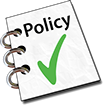 including idling reduction and eco-driving. Not only do drivers and operators better comply with an official measure, but the company's social responsibility and "green" image is enhanced. And, of course, the resulting avoidance in fuel use and engine wear leads to increased profit. For municipal fleets, residents will appreciate knowing that their town employees are saving taxpayer dollars, improving health, conserving energy and lessening the town's/city's carbon footprint. Fleet Idle Reduction Policy Template - PLEASE LET US KNOW IF ADOPTING A POLICY OR PRACTICE.
including idling reduction and eco-driving. Not only do drivers and operators better comply with an official measure, but the company's social responsibility and "green" image is enhanced. And, of course, the resulting avoidance in fuel use and engine wear leads to increased profit. For municipal fleets, residents will appreciate knowing that their town employees are saving taxpayer dollars, improving health, conserving energy and lessening the town's/city's carbon footprint. Fleet Idle Reduction Policy Template - PLEASE LET US KNOW IF ADOPTING A POLICY OR PRACTICE.
Fleet managers: Working with your drivers
Sacramento Clean Cities has worked with the following fleets to implement policies of 5 minutes maximum idling time per day: Coca-Cola Refreshments Co., USPS, and Paladin Private Security.
GREENING FLEETS BEYOND IDLE REDUCTION
With a regulatory push from ARB plus financial incentives, in the last five years California business and municipal fleets have gone green beyond idle-reduction: alternative fuel technologies, hybridization, and electrification for light-, medium- and heavy-duty fleets. Some examples: Pacific Gas and Electric, Coca-Cola Company, Sectran Security Inc., Foothills Transit.
CLEAN CITIES COALITIONS: The U.S. Department of Energy's Clean Cities program advances the nation's economic, environmental, and energy security by supporting local actions to cut petroleum use in transportation. There are nearly 100 local Clean Cities in the U.S. including 12 in California. Clean Cities coalitions provide technical assistance to fleets implementing alternative and renewable fuels, idle-reduction measures, fuel economy improvements, and emerging transportation technologies.
Sacramento Clean Cities idling fact sheet.
